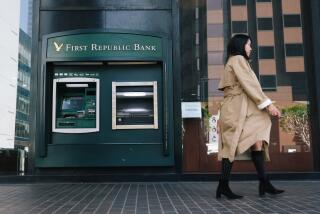U.S. Bailout of Ailing Thrift Industry More Likely, FDIC Chairman Says
- Share via
WASHINGTON — The chairman of the Federal Deposit Insurance Corp. predicted Wednesday that healthy savings and loan associations soon will begin abandoning their own troubled insurance fund in favor of the FDIC, making a taxpayer bailout of the thrift industry more likely.
L. William Seidman, speaking to a group of business editors, said a House vote Tuesday limiting the size of a rescue plan for the faltering Federal Savings & Loan Insurance Corp. also contained an escape hatch for those S&Ls; that can qualify for coverage under the FDIC, the banking industry’s insurance fund. He predicted that many thrifts will take advantage of that escape, leaving the bankrupt FSLIC with only the weakest S&Ls;, themselves close to bankruptcy, as a base of support--”and it cannot recapitalize and survive on that basis.”
The result, he said, is that “somebody else” will have to cover the losses in the industry and reimburse depositors of thrifts that go under--”and that somebody else is obviously the federal government.”
Already, one major California S&L;, Home Federal Savings & Loan, based in San Diego, has asked state and federal regulators for permission to re-establish itself as a state-chartered commercial bank, a move that would cut its ties with FSLIC. Home Federal made its application March 30 but said it would reconsider if FSLIC’s capitalization problems are solved.
The House, under intense lobbying pressure from the U.S. League of Savings Institutions, voted Tuesday to pump $5 billion into the FSLIC over the next two years, rejecting a $15-billion, five-year plan as too expensive. Both plans would be underwritten by the industry.
The FSLIC, which insures some $900 billion in S&L; deposits, has been declared insolvent by government auditors. The General Accounting Office says the fund needs $6 billion more than it has to meet current losses.
The fund has so little ready cash that, instead of closing bankrupt thrifts, it is keeping them open and operating at a loss to avoid having to pay off depositors. The losses, which eventually are likely to fall to the FSLIC, have been estimated at $10.4 million a day.
The Federal Home Loan Bank Board and the Treasury Department said the $15-billion, five-year plan was the minimum needed to ensure that depositors’ money would be protected.
But the industry fought the plan, contending that the size of the problem was uncertain and too large a fund would unnecessarily hurt the healthy segments of the thrift industry while contributing nothing to solving the problem.
Seidman said defeat of the larger plan--which was supported by the White House, the House Democratic leadership and the chairman and ranking Republican on the House Banking Committee--showed the clout of the industry lobbying team.
“More importantly, they’re a bride that brings no dowry,” Seidman said. The thrifts will bring billions in new deposits requiring immediate insurance, but the reserves of the FDIC will go up only gradually, as the thrifts begin paying FDIC premiums and the money accumulates.
Seidman said safe reserves are generally considered to be $1.10 for every $100 in deposits, “and we’re probably at that level right now.”
“If billions of dollars in S&L; deposits come into our fund . . . that level is going to go down,” he said. “We figure it will go down below 0.9 (90 cents per $100 in deposits).”
More to Read
Inside the business of entertainment
The Wide Shot brings you news, analysis and insights on everything from streaming wars to production — and what it all means for the future.
You may occasionally receive promotional content from the Los Angeles Times.










